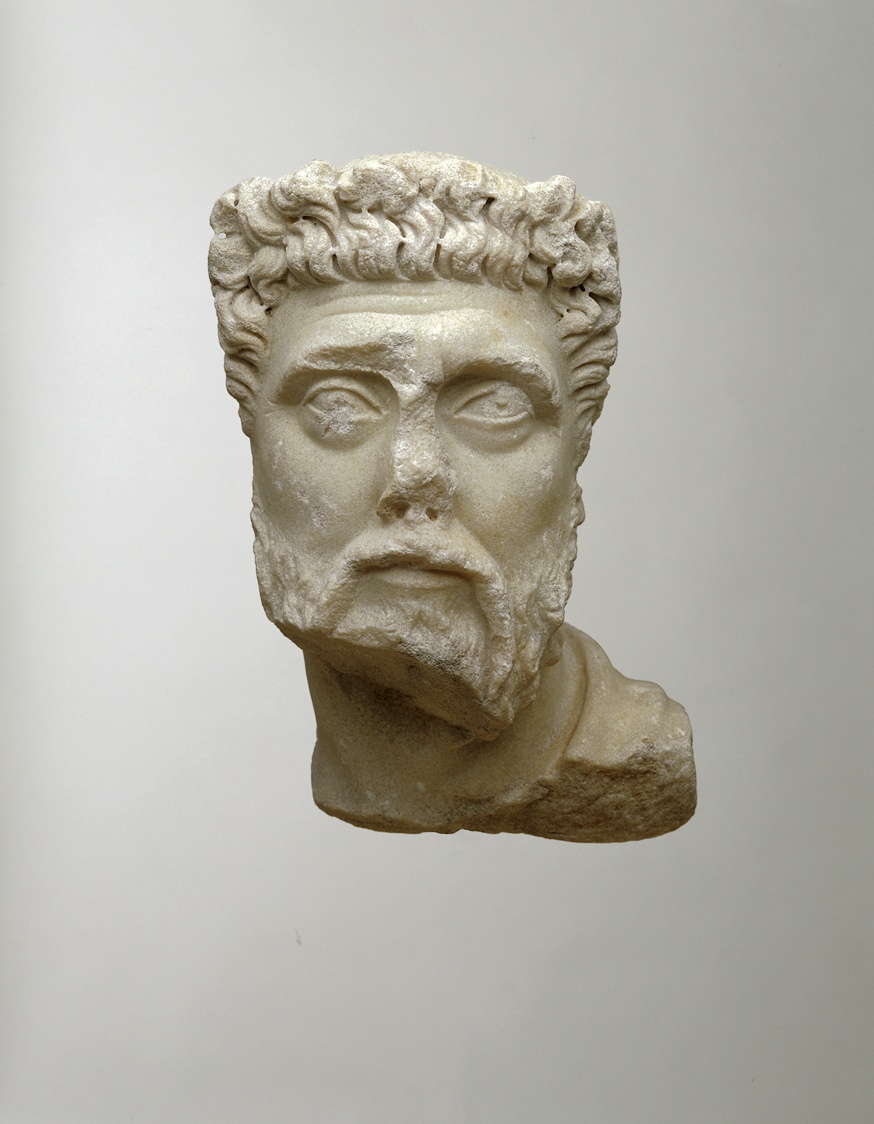
Marble
H: 34.8 cm
Provenance: no indication; Asia Minor
Byzantine
Early-mid 5th century A.D.
Ex collection:
The Marquess of Lansdowne
Sculpted from a block of large-grained marble from Asia Minor, the crystals slightly greyish blue. The curls over the forehead and temples drilled, also the nostrils.
Condition: broken below the Adam's apple in front. Missing: a section of the join of the shoulder to the neck on the right side and the lower chin with the beard; sections of the left ear and all the outer edge of the right ear. Broken away are two thirds of
the right eyebrow from the bridge of the nose and the nose is seriously damaged. The left eyebrow chipped, the upper left eyelid missing on its outer side, abrasion to the lower centre of the right eye with its lower lid and adjoining pouch. The beard and the moustache with its lower right end missing nicked here and there.
A mature portrait full of inner life, he looks out with a pensive intent gaze. A number of portraits of bearded men discovered in Asia Minor display a related style with elongated face, solemn expression and staring gaze. Once again, scholars differ in their assessments and this is no place to enter into a detailed analysis of one of the most difficult and certainly the most fascinating period in ancient portrait sculpture. Thus, he can be dated anywhere between A.D. 380 and 480.
There are two different [1] types of portraits, both ascribed by some to Theodosian times, and one, by others, as a later development. Also, comparisons are made between different traits that characterize examples dated differently. Certain features of this head, such, once again, as his ears (see cat. nos. 245 and 246), his similarity for other features to the head from Sebastopolis in Tokat and related portraits [2], might incline to an early Theodosian date if one accepts, as J. Meischner does, that two facial types are possible for the same epoch. B. Kiilerich does not agree, stating that since none of the three heads [3] have been found in datable contexts, they must be dated on stylistic evidence, and sums up saying that "the facial expression of the c. 380-400 head type is calm and harmonious, whereas that of the c. 450 head type betrays worry and unrest" [4]. The present head does not really fit either characterization and surely belongs in the first half of the 5th century; a reminder that artistic creation is not that easily compartmentalized. Whether it is to be attributed to an Aphrodisian or Ephesian workshop is uncertain, and though two examples from Constantinople, the bust of a priest and the head of a bearded official [5] in Istanbul, do bear some resemblance, we prefer to leave the matter open. Also related are the heads from an unknown location in Asia Minor, now in Karlsruhe and Bonn [6], the latter particularly for the surface treatment.
Exhibited and Published:
Romans and Barbarians, cat. no. 192 A, pp. 174-175 ill.
Gesichter, cat. no. 95, pp. 222-223 ill.
Published :
Kranz, P.: Ein Bildnis frühtheodosianischer Zeit in der Sammlung George Ortiz bei Genf, AA 94, 1979, p. 76 ff.
Meischner, J.: Das Porträt der theodosianischen Epoche I (380 bis 405 n.Chr.), JdI 105, 1990, pp. 303-324, part. 321, ill. 17. Kiilerich, B.: Late Fourth Century Classicism in the Plastic Arts. Studies in the so-called Theodosian Renaissance. Odense University Classical Studies, vol. 18 (Odense, 1993), pp. 237 ff., 384 fig. 108.
Mentioned:
Inan, J., Alföldi-Rosenbaum, E.: Römische und frühbyzantinische Porträt-Plastik aus der Türkei. Neue Funde. (Mainz, 1979) p. 306. - Meischner, J.: Fragen zur römischen Porträtgeschichte unter besonderer Berücksichtigung klein-asiatischer Beispiele, BJb 181, 1981, p. 160 ff. - id.: Zwei theodosianische Priesterköpfe, JbStKSDresden 1988, pp. 24 n. 19, 28. - id.: Das Porträt der theodosianischen Epoche II (400 bis 460 n.Chr.), JdI 106, 1991, p. 407 n. 70. - id.: Das Porträt
der valentinianischen Epoche, JdI 107, 1992, pp. 229
n. 58, 231 n. 64.
1 Meischner, J.: JbStKSDresden, 1988, p. 27 who says that there are two types of faces in this time and that both trends are already visible on the reliefs on the base of the Theodosian obelisk. The groups are determined by their content rather than by their shapes. There is a court or academic portraiture - two examples of which are the priests in Athens and Dresden - and a more realistic type - the present portrait and the ones in Karlsruhe and Tokat.
2 Meischner, J.: JdI 105, 1990, ill. 13.
3 The present portrait and the ones in Karlsruhe and Tokat.
4 Kiilerich, B.: Late Fourth Century Classicism in the Plastic Arts, p. 241.
5 Inan, J., Alföldi-Rosenbaum, E.: Römische und Frühbyzantinische Porträtplastik aus der Türkei, no. 274, pp. 282-286, pl. 252; no. 275, p. 286, pl. 260.
6 Karlsruhe, private collection: Meischner, J.: op. cit.
(footnote 2), ill. 18. - Bonn, Akademisches Kunstmuseum B 287: Meischner, J.: JdI 106, 1991, ill. 92,1 (placed A.D. 400-420).